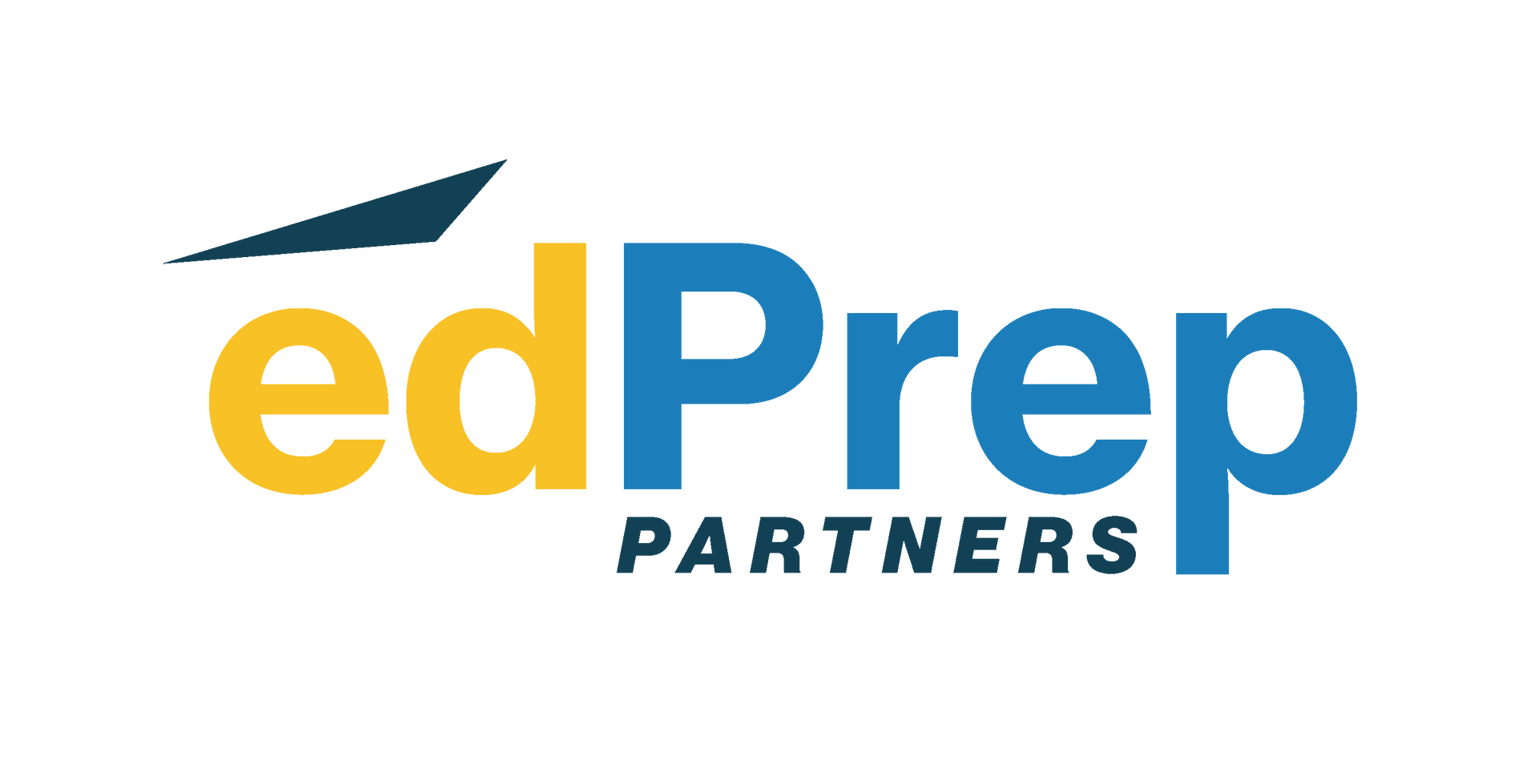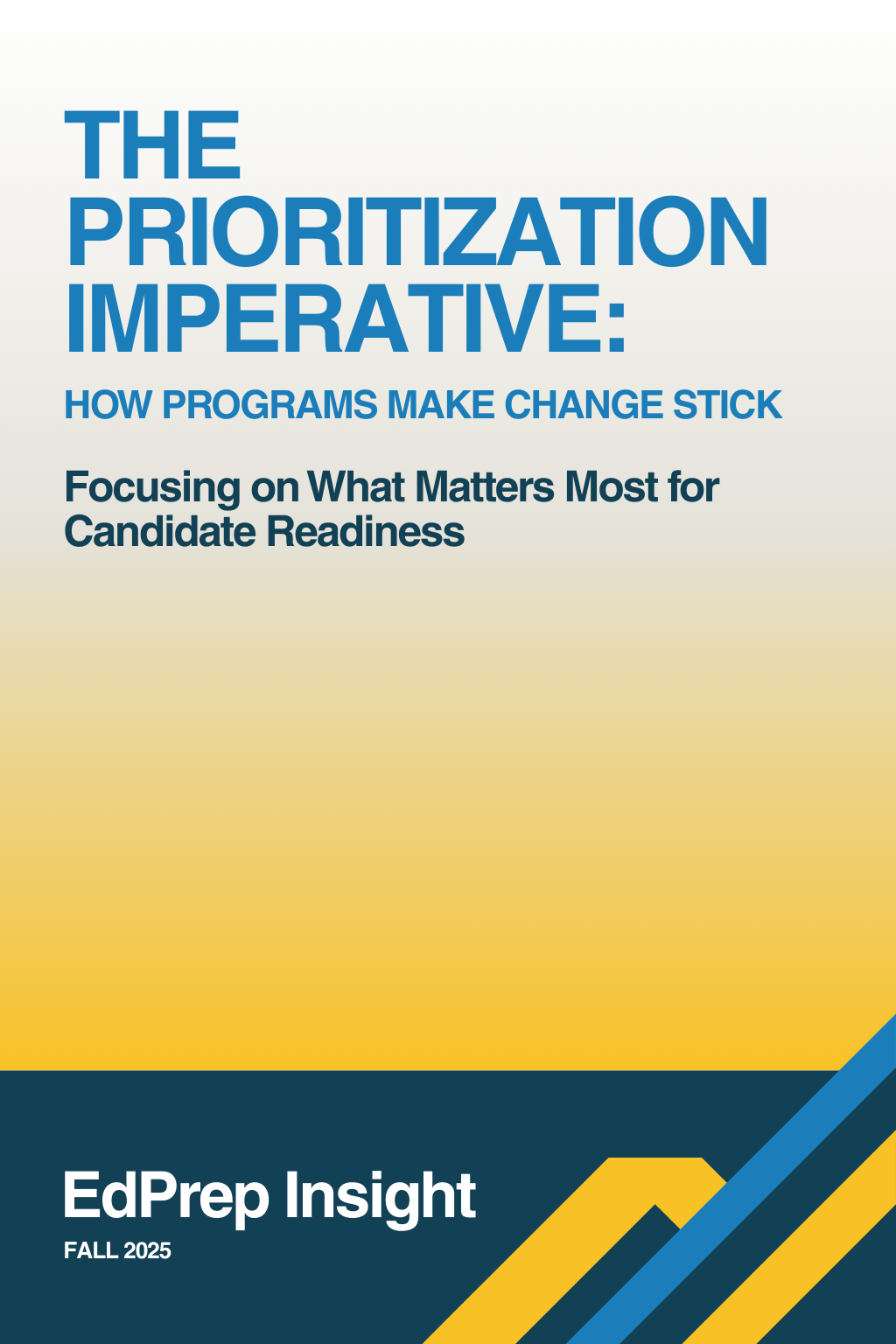The Prioritization Imperative: How Programs Make Change Stick
The Prioritization Imperative: How
Programs Make Change Stick
Focusing on What Matters Most for Candidate Readiness
The Power of Focus
Educator preparation programs often try to fix everything at once: new frameworks, new pathways, new partnerships, new requirements. The result is predictable: initiative overload, surface level change, and candidates who do not get the preparation they deserve.
As the saying goes, when everything is a priority, nothing is.
This EdPrep Insight highlights how programs serious about dramatic improvement narrow their focus to a few high leverage shifts, sequence change through Strategic Action Plans (SAPs) and a phased improvement approach, and reinforce focus with disciplined data routines that bring teacher educators together around improvements in candidate preparation and experiences.
Why Prioritization Matters: What’s at Stake
Research across fields is clear: spreading change too thin produces fatigue, weak implementation, and little impact. Lasting improvement comes from narrowing focus, sequencing efforts, and holding the line on what matters most.
Every program leader has lived it: a new mandate from the state, a promising partnership opportunity, another framework to align to, and an urgent grant requirement - all arriving at once. The instinct is to take on everything. The outcome is predictable: initiative overload. Faculty and clinical supervisors inevitably feel scattered, action items pile up, and candidates’ preparation experiences begin to fragment.
Across disciplines, the evidence points to the same truth: lasting improvement does not come from doing more. It comes from doing a few things deeply, and well.
Improvement Science: Define the Problem, Test the Solution
Anthony Bryk and colleagues remind us that progress begins with a sharply defined problem of practice. Too often, programs fall into “solutionitis” - adopting broad reforms without clarifying the real problem. Improvement science instead calls for narrowing the focus and running small, rapid tests of change before scaling. Each test yields evidence about what works, for whom, and under what conditions. Over time, this disciplined inquiry produces scalable, reliable improvement.
Implementation Research: Overload Creates Fatigue, Not Change
Dean Fixsen and the National Implementation Research Network (NIRN) have shown that implementation succeeds when it is staged and supported by aligned drivers: competency (training and coaching), organization (systems and infrastructure), and leadership. When programs try to implement everything at once, none of these drivers get adequate attention. The result is what Douglas Reeves calls the law of initiative fatigue: as initiatives multiply, the time, energy, and resources for each one dwindle, and impact collapses.
Lessons from System Change: Choosing the Right Drivers
Michael Fullan describes the trap of “wrong drivers”: piling on new mandates, compliance tasks, or fragmented programs that give the illusion of progress but fail to change practice. The alternative is what he calls simplexity: focusing on a small number of high-leverage drivers, pursuing them with depth, and aligning everything else behind them.
Proof This Works
The logic of prioritization is not unique to education, and it’s proven to work:
- Healthcare: The Institute for Healthcare Improvement’s 100,000 Lives Campaign didn’t ask hospitals to improve everything. It focused on six specific interventions. The result: more than 122,000 lives saved in 18 months.
- K–12 systems: The Peel District in Ontario reduced overload by pruning initiatives and focusing on four strategic goals. Teachers reported renewed clarity, and student outcomes improved.
- Individual schools: In Garden Grove, California, leaders resisted scattershot reforms and instead rallied staff around a few shared goals, building coherence and producing sustained literacy gains.
Whether in healthcare, K–12, or educator preparation, the evidence is clear: focus is not a constraint. Focus is the condition for sustained improvement. Programs that try to do everything at once rarely change much at all. Programs that choose a vital few priorities, sequence them, and hold attention are the ones that produce measurable shifts in practice and outcomes.
System Design: How EdPrep Partners Approaches Change
At EdPrep Partners, we see prioritization as system design. The EdPrep Performance Framework and the 14 Levers for Quality Teacher Preparation define what strong preparation looks like in action. But improvement does not come from pulling all 14 levers at once. It comes from selecting the right levers for the moment based on where a program currently is, sequencing those levers and corresponding actions across an intentional period of time, and building capacity and structures either within existing systems or from the ground-up. Most importantly, it means leveraging what already works and holding focus until the changes show up in teacher educator and candidate performance.
Choose a vital few, on purpose.
The EdPrep Partners 14 Key Levers for Quality Teacher preparation are all essential for high quality preparation. But programs cannot pull them all with equal force at the same time. Improvement requires a methodical order, identifying which levers are of highest priority right now and which will drive the most significant improvement in candidates’ developmental experiences and readiness.
We help teams prioritize the Key Levers that will have the strongest line of sight to candidate readiness, which often begins with a program’s vision for quality teaching & learning, extends to teacher educator practices, and then considers how data can support alignment within, across and external to the program to better meet the workforce needs/priorities in the field. The outcome of this step is explicit: a short list of near term priorities, goals, actions, and metrics for progress monitoring change.
Sequence before you scale.
Depth requires pacing. We guide programs to stage both what changes and how changes are introduced over time, planning for what happens next week, in six weeks, over a semester, across a year, and through a three year trajectory. A clear roadmap gives program leadership, faculty, and clinical supervisors the confidence and processes they need to enact changes with fidelity and to reinforce new expectations as they take hold. Sequencing protects people from initiative overload and protects the work from shallow adoption.
Build the conditions for focus.
Sustained focus is only possible when the right conditions are in place. At EdPrep Partners, we use the Four C’s as the readiness screen for whether change will stick and scale:
- Commitment: Leaders demonstrate visible will, urgency, and sponsorship for improvement, backed by time, resources, and capacity.
- Capacity: Faculty, clinical supervisors, and mentors have the people, time, and basic systems needed to enact new practices with quality.
- Clarity: Goals, measures, and expectations are shared, simple, and aligned to what matters most for candidate readiness.
- Collaboration: Candidates, teacher educators, P-12 districts, and community partners are all engaged in both the decision-making and the implementation.
We help state agencies, regional collaboratives, and teacher preparation programs assess, strengthen, and monitor these conditions so that chosen priorities can take root, spread, and endure through leadership, staffing, policy, or environmental changes.
Lead from your locus of control.
Programs gain traction fastest when they begin where authority, influence, and ability to impact change are strongest. We guide teams to focus first on what they can control — program design, faculty expectations, clinical supervision protocols, tools, training and development, and candidate experiences. From there, we help them influence what they can — such as partnership agreements, calendars, and shared practices with districts. Finally, we prepare them to navigate what is beyond their control without letting it dictate the agenda or distract from the work. This discipline keeps energy aimed at changes that can be implemented with quality and sustained over time.
Design for practice.
The real test of prioritization is whether teacher educators change how they prepare candidates through their practices, the environments they create, and the routines they model, and what they prepare candidates to do through the methods, instructional moves, and content pedagogies that matter most for readiness. Success is measured by whether candidates can demonstrate these practices against shared standards in both coursework and clinical experiences.
Guardrails that protect focus.
Every priority is anchored in a clear aim, a focused set of action steps, a near term win window, and defined owners. Just as important, every plan also identifies what will not be added during the term. These guardrails keep agendas, professional learning, and project management aligned to the same targets until evidence shows the work is landing. By naming both the work to pursue and the work to defer, programs protect faculty and clinical supervisors from overload and ensure that chosen priorities move from plan to practice.
Operationalizing Change: The Playbook
Strong programs do not rely on willpower alone. They put structures in place that protect focus: Strategic Action Plans that anchor one or two priorities, phased models that define what happens now versus later, and data routines that keep attention on the chosen goals.
1. Strategic Action Plans (SAPs)
A Strategic Action Plan is the anchor document that turns broad aspirations into focused, near term work. A well designed SAP answers five questions:
- Aim: What one or two priorities are we pursuing this term?
- Drivers: What specific practices, structures, or conditions must change to make progress?
- Milestones: What 90 to 120 day wins will show evidence of progress?
- Evidence: What data, artifacts, or observations will we use to know it is working?
- Owners: Who is responsible, and by when?
Equally important is naming what will not be added this term. These guardrails prevent initiative creep and keep agendas disciplined.
For example, a program might set an aim of improving candidate rehearsal and feedback cycles. The SAP would specify drivers such as faculty & clinical supervisor modeling & labeling criteria-driven feedback, rehearsal opportunities, and each of the elements of quality coaching. Milestones might include teacher educator professional development, practice opportunities, shadowing or observations, peer feedback, and candidate survey data.
SAPs become the plan of record for program leaders, faculty, and clinical supervisors. Meeting agendas, professional learning, and all corresponding coaching cycles are aligned to the SAP, ensuring energy is directed toward the Key Lever of focus rather than scattered across competing initiatives.
2. Phased Improvement
Change is more sustainable when sequenced over time. EdPrep Partners uses a three phase approach that helps programs distinguish between what happens now, and what comes later:
Diagnose & Plan
- Conduct diagnostic reviews to surface strengths and gaps
- Use prioritized stakeholder questions and artifact reviews to identify high leverage levers
- Co create an initial SAP with near term wins
Implement and Early Scale
- Support faculty, clinical supervisors, and mentors to put new practices into action
- Provide modeling, professional learning, and coaching aligned to SAP drivers
- Capture early evidence of candidate and teacher educator practice shifts
- Evaluate fidelity before expanding
Sustain and Monitor
- Embed routines that ensure practices stick across semesters
- Adjust and refine based on evidence
- Decide whether to deepen the same lever or add a new one
Each phase has gates: clear evidence criteria that determine whether a program is ready to move forward. These gates prevent programs from scaling new practices before they are ready and keep attention fixed on current priorities until they are solid.
3. Data Routines That Hold Focus
Data routines are the discipline that sustains prioritization. They are not compliance exercises. They are structured, repeatable processes that ensure data is not just collected but actively interpreted, discussed, and used to improve candidate preparation. When implemented with consistency, data routines clarify not only what happened but also what should happen next.
A strong data routine keeps action close to the candidates’ developmental experiences. Faculty, clinical supervisors, mentors, and candidates themselves use timely evidence to adjust instructional practices, coaching approaches, and supports in ways that directly impact candidate development.
A simple monthly or bi monthly routine might include:
- Agenda: 75 minutes, with 80 percent devoted to current SAP priorities
- Artifacts: candidate observation and signature assignment data, rehearsal performance results, coaching feedback notes (faculty and clinical supervisors)
- Questions:
- Are candidates enacting the instructional practices - methods, pedagogies, and content knowledge - along the program’s developmental trajectory with consistency?
- What trends are emerging in candidate performance?
- Which teacher educator practices are promoting or deterring candidate growth?
- What does teacher educator performance reveal about readiness?
- What trends are visible in disaggregated data compared to aggregate data?
At their best, data routines do two things at once: they reinforce or refine focus by keeping the chosen lever at the center of discussion, and they surface near term wins by highlighting evidence of progress to celebrate and build momentum.
We explore this idea in greater depth in a previous EdPrep Insight, From Data Collection to Daily Practice: How Strong Data Routines Improve Teacher Preparation. Read here
Measures of Progress: Depth Over Breadth
The best signal of successful prioritization is not the number of initiatives launched. It is the evidence that one or two critical improvements are implemented with depth, sustained across semesters, and visible in both teacher educator practices and candidate enactment. At EdPrep Partners, we look for progress across four dimensions:
1. Implementation Fidelity
The first signal is whether the plan is being executed with discipline.
- SAP milestones completed on time, showing that 90 to 120 day wins are achieved
- Leadership, faculty, and clinical supervisor meetings aligned to stated priorities
- Calibration checks showing implementation in programmatic experiences
These indicators reveal whether programs are sticking with their priorities rather than drifting back into overload.
2. Practice Change
The real test of prioritization is what happens in the daily work of teacher educators and candidates.
- Faculty and supervisors enacting practices tied to the chosen priority area(s)
- Candidates demonstrating stronger performance on prioritized skills in rehearsals, coursework, and clinical observations
- Coursework and clinical expectations aligned so all teacher educators are reinforcing the change
When prioritization is working, practice across the program becomes coherent, not just compliant on paper.
3. Sustained Focus
Improvement is fragile unless it survives the inevitable turnover and shifting pressures.
- Priorities carried consistently across two or more terms, even with leadership or staffing changes
- Practices and routines institutionalized over two or more years so they become standard operating procedures rather than temporary projects
Depth requires persistence. Sustained focus shows that programs are embedding change rather than launching initiatives that fade.
4. Guarding the Gains
Strong programs protect improvements even as new priorities emerge.
- Evidence that gains from prior terms are still holding
- No regression in candidate performance or faculty practices tied to earlier Key Levers
- Standard operating procedures in place so progress does not depend on one leader or champion
Guarding the gains ensures improvement is cumulative. Each new priority builds on the last rather than replacing it.
Let’s Give Them One
Dramatic improvement does not come from doing everything. It comes from doing the right things, deeply and well. Programs that choose a vital few priorities, sequence them with discipline, and sustain them through practice based routines are the ones that change what candidates experience, how they perform, and ultimately the outcomes of P12 students.
At EdPrep Partners, we help programs focus, sequence, and sustain the improvements that matter most. Because every child deserves an excellent educator.
Let’s give them one.
Calvin J. Stocker
Founder & CEO, EdPrep Partners
Stay Connected
If you're interested in learning more, exploring collaboration or technical assistance, or just want to catch up, we’d love to connect:
About EdPrep Partners
Elevating Teacher Preparation. Accelerating Change.
EdPrep Partners is a national technical assistance center and non-profit. EdPrep Partners delivers a coordinated, high-impact, hands-on technical assistance model that connects diagnostics with the support to make the changes. Our approach moves beyond surface-level recommendations, embedding research-backed, scalable, and sustainable practices that most dramatically improve the quality of educator preparation—while equipping educator preparation programs, districts, state agencies, and funders with the tools and insights needed to drive systemic, lasting change.



